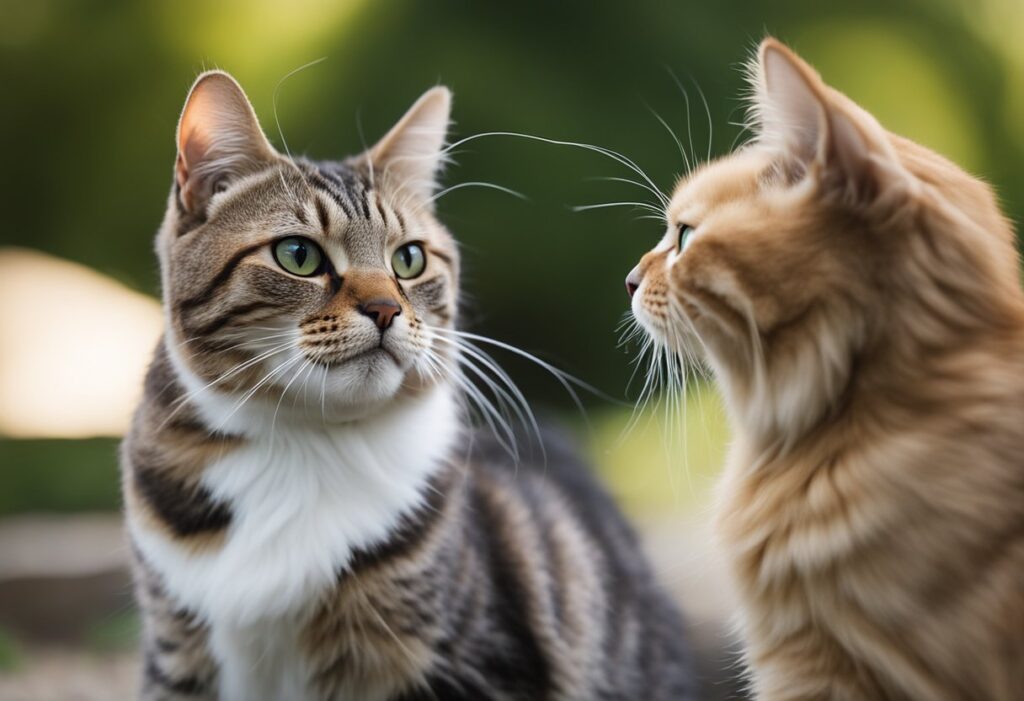From my personal experience, every female cat I’ve had seemed aggressive, at first. I’ve even had people say this. However, having spent a lot of time with female cats, they can female cats are more aggressive. Rather, they are territorial.
Below are some of the factors that can cause aggression in female cats:

1. Hormones
Hormonal changes can cause aggression in female cats.
When a female cat is in heat, she may become more aggressive towards other cats, especially if there is competition for a mate. This behavior is often accompanied by yowling, hissing, and other vocalizations. Spaying a female cat can help reduce her aggression levels.
2. Lack of socialization
Cats that have not been socialized properly may become more aggressive towards other cats and humans.
Socialization involves exposing a cat to different people, animals, and environments from an early age. A lack of socialization can cause a cat to become fearful and aggressive.
3. Medical conditions
Medical conditions such as hyperthyroidism, osteoarthritis, dental disease, and central nervous system problems can cause aggression in cats.
It is essential to consult a veterinarian before attempting to manage aggressive cats through behavioral and/or environmental modification.
4. Stress
Stressful situations can cause aggression in female cats.
Cats may become aggressive when they feel threatened or stressed. Common stressors include changes in the environment, loud noises, and the presence of other cats or animals.
5. Territorial behavior
Female cats can become territorial, especially if they feel that their territory is being threatened. Territorial behavior can cause aggression towards other cats and humans.
6. Maternal Instincts
Female cats also have strong maternal instincts. They are protective of their kittens and will defend them from any perceived threat. This protective behavior can extend to their owners, especially if they perceive them as a threat to their kittens. This behavior can sometimes result in aggression towards humans.
As a cat owner, it is essential to understand the underlying causes of aggression and take appropriate measures to manage it.
Behavioral Traits of Female Cats
Comparative Aggression: Male vs. Female Cats

As a cat owner, it’s essential to understand the social dynamics and behavior of your feline friends, especially when it comes to aggression. While cats are generally known for their independent and aloof nature, they can also exhibit aggressive behavior, which can be concerning for pet parents.
Social Dynamics
When it comes to aggression, the social dynamics of male and female cats are different. Male cats are generally more territorial and aggressive towards other males, particularly when they are not neutered. On the other hand, female cats tend to be more aggressive towards other females, especially when they are in heat.
However, it’s worth noting that aggression in cats can be influenced by several factors, such as age, breed, and past experiences. For instance, a cat that has had negative experiences with other cats in the past may exhibit aggressive behavior towards other cats, regardless of their gender.
Effects of Neutering

Neutering is a common procedure that involves removing a cat’s reproductive organs. This procedure can have a significant impact on a cat’s behavior, including aggression. Neutering can reduce a male cat’s territorial and aggressive behavior towards other cats, while it can also make female cats less aggressive towards other females.
According to a study by Cornell University College of Veterinary Medicine, neutering can also reduce other forms of aggression in cats, such as petting-induced aggression. This type of aggression occurs when a cat becomes overstimulated during petting, leading to aggressive behavior. Neutering can help reduce this behavior, making cats more affectionate and less aggressive towards their owners.
In conclusion, while female cats may be more aggressive than male cats in certain situations, it’s important to understand that aggression in cats is influenced by several factors. Neutering can also have a significant impact on a cat’s behavior, including reducing aggression towards other cats and humans. As a cat owner, it’s crucial to provide your feline friend with a safe and nurturing environment that promotes positive behavior and reduces stress.
Health Issues Leading to Aggression

As with humans, health issues can also lead to aggression in female cats. Two common causes of health-related aggression in cats are pain-induced aggression and medical conditions.
Pain-Induced Aggression
Cats can become aggressive when they are in pain. This can be due to an injury, arthritis, dental pain, or other painful conditions. Pain-induced aggression can be triggered when a cat is touched or handled in a painful area. The cat may lash out and become aggressive to protect itself from further pain.
It is important to note that punishment is not an effective way to change a cat’s behavior when it comes to pain-induced aggression. Instead, it is important to identify and treat the underlying cause of the pain. Once the pain is managed, the cat’s aggressive behavior may improve.
Medical Conditions
Medical conditions such as hyperthyroidism, brain tumors, and seizures can also lead to aggression in female cats. These conditions can cause changes in a cat’s behavior, including aggression.
If a cat suddenly becomes aggressive, it is important to take her to the vet for a check-up. The vet can perform a physical exam and run tests to determine if there is an underlying medical condition causing the aggression. If a medical condition is identified, appropriate treatment can be prescribed to manage the condition and improve the cat’s behavior.
In conclusion, health issues can lead to aggression in female cats. Pain-induced aggression and medical conditions are two common causes of aggression in cats. It is important to identify and treat the underlying cause of the aggression to improve the cat’s behavior.
Managing Aggression in Female Cats

As a cat owner, it’s important to understand that aggression in female cats is a common issue that can be managed with proper care and attention. Here are some ways to manage aggression in female cats:
Environmental Enrichment
Environmental enrichment is an effective way to manage aggression in female cats. This involves creating a stimulating and comfortable environment for your cat. Some ways to do this include:
- Providing plenty of toys and scratching posts
- Creating perches and hiding spots
- Providing a clean litter box
- Ensuring access to fresh water and food
Behavioral Training
Behavioral training is another effective way to manage aggression in female cats. This involves teaching your cat to behave in a more appropriate way. Some ways to do this include:
- Rewarding good behavior with treats
- Ignoring bad behavior
- Redirecting aggression with toys or play
Veterinary Intervention
If your cat’s aggression is severe, it may be necessary to seek veterinary intervention. Your vet can help identify the underlying cause of your cat’s aggression and recommend a course of treatment. Some underlying medical conditions that can cause aggression in cats include:
- Hyperthyroidism
- Osteoarthritis
- Dental disease
- Central nervous system problems
How does gender affect territorial behavior in cats?

Gender can play a role in territorial behavior in cats.
Female cats tend to be more territorial than their male counterparts, especially when it comes to other female cats. This is because female cats have a stronger instinct to protect their young and their resources, such as food and shelter. Male cats, on the other hand, are more likely to roam and explore their surroundings, which can lead to less territorial behavior.
Is there a difference in personality traits between male and female cats?
While there is no definitive answer to this question, some studies have suggested that there may be slight differences in personality traits between male and female cats.
For example, female cats may be more independent and less affectionate than male cats, while male cats may be more outgoing and sociable. However, these differences are not always consistent and can vary from cat to cat.
Can spaying or neutering affect a female cat’s aggression levels?
Spaying or neutering can have a positive effect on a female cat’s aggression levels. This is because spaying or neutering can reduce the levels of hormones such as estrogen and testosterone, which can lead to more aggressive behavior.
Spaying or neutering can help to reduce territorial behavior, as it can eliminate the desire to protect resources such as food and shelter. However, it is important to note that spaying or neutering is not a guaranteed solution to aggression in cats, and other factors such as socialization and environmental enrichment may also need to be addressed.
